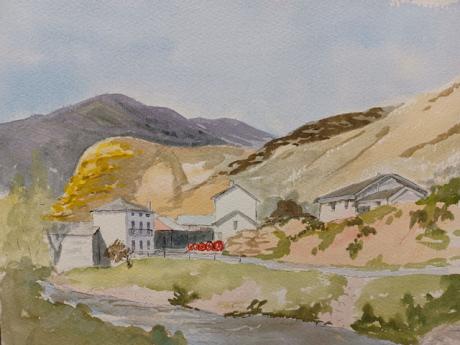" P Yates" and inscribed on the reverse
Unframed
Portilla de la Reina is a Spanish town belonging to the Municipality of Boca de Huérgano , within the province of León , in the Autonomous Region of Castilla y León . Previously, Portilla de la Reina had its own town hall. The title of town was granted to Portilla by King Ferdinand VI of Spain in 1755. The Yuso River , a tributary of the Esla , passes through the town . In the past, the Yuso was considered the source of the Esla River . The town is located between four crags of conglomerate rock: el Cuervo, la Cuesta, la Cruz and el Cincho; placing the town in an easily defensible position, so it is believed that there could have been a castle on the El Cincho rock.
Near Portilla de la Reina, there is the Pico Tres Provincias in the Fuentes Carrionas massif . This mountain acts as a common limit between the provinces of León , Palencia and Cantabria . Portilla de la Reina, is located within one of the regions of the natural spaces of Castilla y León , specifically in the Riaño and Mampodre Mountains , and bordering one of the most important national parks in Spain : the Picos National Park. from Europe . The latter is the only national park that exists in the Castilian and Leonese Community . In addition, the regional park in which Portilla de la Reina is included is also the only park that enjoys this distinction in Castilla y León , along with Sierra de Gredos in Ávila.
Portilla de la Reina is cloistered in the Port of San Glorio , whose maximum height is 1,609 meters above sea level. This mountain pass joins the Cantabrian coast with the Meseta and overcomes one of the greatest slopes that can be found in Spanish ports. The controversial creation of the "San Glorio" Ski Resort revolves around this mountain pass.
The town of Portilla is made up of two neighbourhoods: the Barrio de la Mula and the Barrio de la Iglesia, separated by the Yuso River , which in this section runs under the Puente Grande, located in the center of the town.
The Barrio de la Mula is the oldest neighborhood in Portilla de la Reina and it is believed that the name of the neighborhood is given by its main street: Calle de La Mula. This neighborhood is somewhat larger than its neighboring neighborhood, that of the Church.
The Barrio de la Iglesia, as its name suggests, is where the church of Portilla de la Reina, dedicated to Santo Tomás , is located .The Patron of Portilla de la Reina is San Roque , whose celebration is on August 16 . The Portilla de la Reina festivities revolve around August 16 ; August 15 is the day of Our Lady and August 17 , the day of San Roquín.

